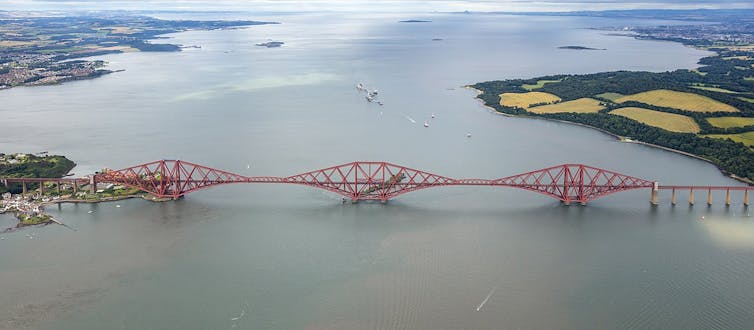As rescue workers look for survivors in the concrete rubble that used to be part of the Morandi bridge in Genoa, Italian authorities are starting their investigation into the possible causes behind this terrible tragedy.
It is too early to determine what may have caused the catastrophic collapse of more than 100 metres of the multi-span, cable-stayed suspension bridge, completed just over 50 years ago. But it’s important to understand that bridge engineering does not end when construction finishes and traffic starts to flow. In fact, properly looking after a bridge during its long life is as crucial as having a good design, using high-quality materials, and ensuring sound workmanship during construction.
Modern bridges are designed for a life of 100 years, though many centenarian bridges – such as the Forth Bridge in Scotland, which opened in 1890 – still provide sterling service, and of course there are smaller bridges built of stone to more ancient designs that have stood for many hundreds of years. Considering the number of bridges built in Europe during the expansion of the motorway networks from the late-1950s onwards we should expect, and be prepared for, many to exceed their planned lifespan in coming decades. Facilitating this is ambitious but necessary, and made possible thanks only to regular inspection and maintenance that ensures that building materials have not degraded, and that structural elements are fit to bear the traffic and environmental loads they face.
The Forth Bridge outside Edinburgh, one of Britain’s iconic bridges, is more than 100 years old. Andrew Shiva
So what are the factors that affect the strength of a bridge and may compromise public safety?
Environment and climate
The climate in a bridge’s location, taken alongside atmospheric pollution common in cities, can have an adverse influence on the material of the bridge – for example, the corrosion of steel reinforcement or pre-stressed steel tendons embedded in concrete. Regular inspections are typically scheduled every six years for large bridges to identify any degradation, and to take appropriate measures to replace cracking concrete and corroded steel, or to introduce protective coatings.
In England, the Midlands Link motoway viaducts, comprising 13 miles of elevated motorway carrying the M5 and M6 motorways around Birmingham, suffered from chloride-induced steel corrosion early on in their life from exposure to salt used to de-ice the roads. This required an extensive application of corrosion protection measures in the early 1990s. More than 700 structures have benefited from this action, demonstrating the cost savings that can be made if appropriate action is taken at the right time.
Stress and fatigue
Fatigue caused by use is another factor, and inspectors will look out for tell-tale signs of failure often associated with the cyclical stress produced by passing vehicles, particularly heavy trucks. This type of failure is especially relevant for metal bridge decks and the cables of suspension and cable-stayed bridges. Traffic has increased ever since these bridges were built, which inevitably leads to the need for more maintenance and strengthening work, such as additional steel, glass or carbon fibre-reinforced plates on critical parts in order to restore or enhance their strength compared to what was deemed necessary during their design. For example, Network Rail in the UK used fibre-reinforced polymers to strengthen more than 20 bridges carrying highway or railway traffic between 2001 and 2010.
Consider how we all tend to react to a road sign bearing the words: “Essential Bridge Works – Expect Long Delays”. One such situation prompted this comment from a member of the public: “We are doomed. I am going to buy a tent and pitch it outside work for the three months while the misery goes on.” Perhaps knowing why this is necessary – and the consequences of not doing so – might persuade people to change such views.
Money and willingness to spend it
Equally we must understand that maintenance budgets need to be set at levels that far exceed those that would allow engineers only to “firefight” the most severe problems, as is becoming worryingly commonplace. Instead budgets need to allow for planned interventions and necessary upgrades over many decades. That requires public and government support, as well as skilled engineers committed to ensuring the safety of an ageing structure.
There are challenges in devising improved methods to assess bridge strength, developing new repair techniques, and new ways of collecting and using inspection and monitoring data to provide advance warning of problems. These constantly push technological boundaries, making it possible to operate existing bridges safely during their long service lives. And the experience gained feeds into new designs that will become reality in years to come.
Those investigating the collapse of the Morandi bridge will look at inspection and maintenance matters. Other lines of enquiry will no doubt include the unusual design of the multi-span bridge, with only a few cable stays to transfer deck loads to the towers, the ongoing work to shore up the foundations, and the heavy rainfall at the time of the collapse. In the shadow of this terrible loss of life, it is worth remembering that bridge inspection and maintenance may be annoying for commuters – but it is crucial.



 Fed Near Neutral Signals Caution Ahead, Shifting Focus to Fixed Income in 2026
Fed Near Neutral Signals Caution Ahead, Shifting Focus to Fixed Income in 2026  Asian Fund Managers Turn More Optimistic on Growth but Curb Equity Return Expectations: BofA Survey
Asian Fund Managers Turn More Optimistic on Growth but Curb Equity Return Expectations: BofA Survey 
































